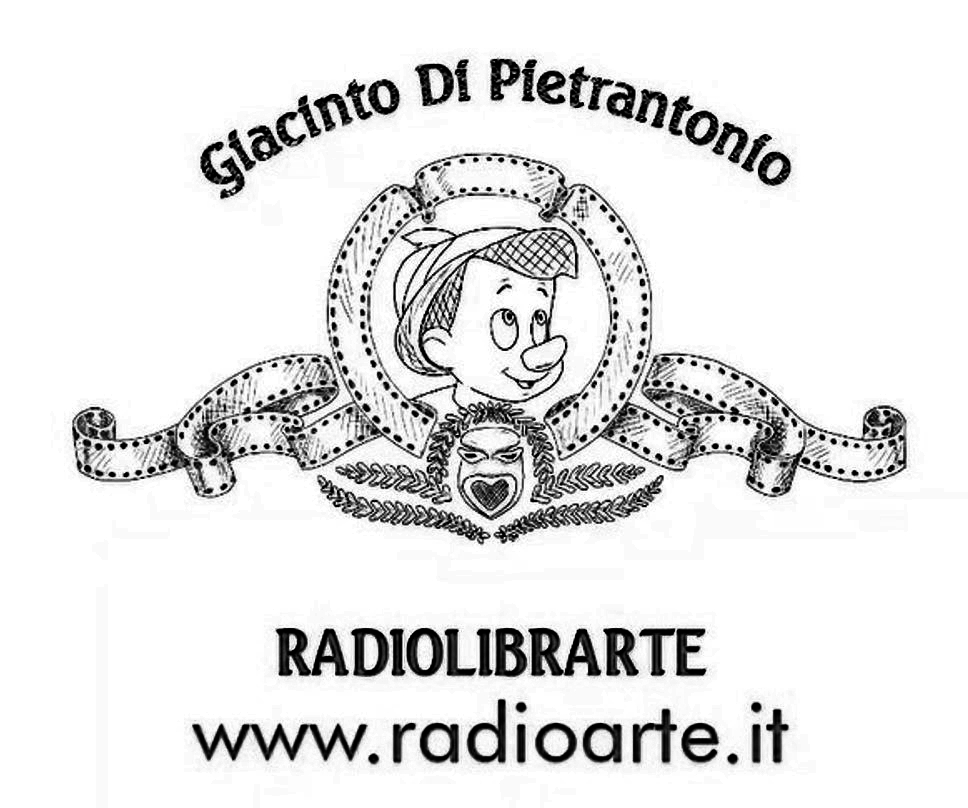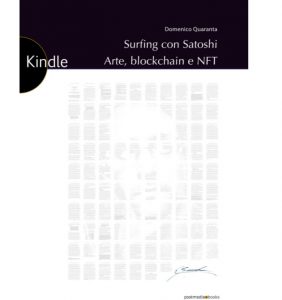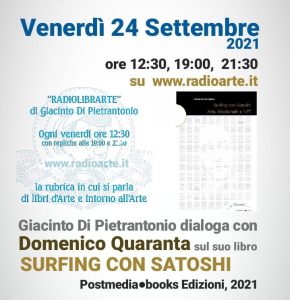
RADIOLIBRARTE
Giacinto Di Pietrantonio dialoga con Domenico Quaranta sul suo libro “Surfing con Satoshi”, Postmedia-books, 2021

Rubrica ideata e condotta da Giacinto di Pietrantonio su libri di, per e introno all’arte.
Surfing con Satoshi
La Media art, come il Bitcoin, cerca di gestire le contraddizioni della scarsità digitale limitando l’illimitabile.
_ Hito Steyerl 2016
All’inizio del 2021, il boom del mercato degli NFT (Non Fungible Token, certificati digitali di autenticità) ha aperto nel mondo dell’arte il dibattito sulla blockchain, il registro pubblico decentralizzato su cui questi certificati convivono con le criptovalute, promettendo “scarsità digitale verificabile.” In realtà la blockchain, sorta all’inizio della crisi finanziaria del 2008 e vista da molti come il fondamento di un nuovo Web 3.0 più privato e sicuro, ha già cambiato l’economia mondiale e sta ridisegnando l’ambiente digitale in cui, sempre più, anche l’arte si trova a essere creata, distribuita e scambiata. Nato nel tumulto di un hype tecnologico e di una bolla speculativa, questo volume colloca le promesse del mercato degli NFT in una prospettiva storica che approfondisce e analizza sia gli sviluppi delle tecnologie su cui si fonda, sia il ruolo di certificati e contratti nell’arte contemporanea, sia le vicende del mercato della media art nel corso degli ultimi trent’anni. Cavalcando l’onda di un dibattito in corso, Surfing con Satoshi affronta una serie di domande ancora aperte, come: cosa ha a che fare l’arte con la blockchain? Ha senso parlare di “Crypto Art”? Che cosa la definisce, a parte il modo in cui viene scambiata? Che cosa c’è in questo mondo, oltre alla speculazione? Come è possibile attribuire il carattere dell’unicità a un file digitale infinitamente riproducibile? La promessa di disintermediazione della blockchain distruggerà il mondo dell’arte come siamo abituati a conoscerlo? Come sta reagendo quest’ultimo? Gli NFT sono un’opportunità o una truffa ai danni degli artisti? Chi sono i collezionisti disposti a pagare milioni per un certificato di autenticità, e perché lo fanno? Perché le arti visive sembrano aver acquisito un ruolo tanto centrale nell’economia delle criptovalute?
Come molte delle cose che ho scritto, questo testo nasce dalla fiducia nella scrittura come mezzo per articolare e sviscerare questioni complesse, e dallo sforzo di offrire a me stesso e ai lettori gli strumenti concettuali utili per elaborare una propria risposta a domande destinate altrimenti a restare in sospeso. Esploro ormai da diversi anni il territorio scivoloso della “digital art”, anche se ho sempre rifiutato questo e altri termini utili solo ad alzare barriere insormontabili tra le pratiche artistiche, e nel contempo a generare associazioni inutili e dannose tra sfere della creazione che possono coesistere solo all’interno di una caratterizzazione così fumosa e generica come quella offerta dal mezzo (un mezzo, nel caso specifico, tanto più indefinibile in quanto concepito e progettato come “metamedium”, che fagocita e trasforma ogni altri mezzo e linguaggio). […] Nel corso di questo libro, abbiamo fatto surf con Satoshi Nakamoto, cavalcando l’onda da lui stesso generata quando ha progettato una tecnologia che fosse in grado di rimpiazzare le strutture gerarchiche con un’infrastruttura decentralizzata e paritaria, la legge dello stato con la legge del codice. Come abbiamo visto, una volta resa operativa, la legge del codice può diventare immutabile: questa è la sua promessa, e la sua minaccia. Ma dietro al codice ci sono pensieri, e dietro i pensieri, persone. Questa è la ragione per cui critica culturale, scienze sociali, filosofia e arti sono tanto importanti nella definizione di questo nuovo spazio. Questa è la ragione per cui ogni mondo dell’arte ha il dovere di portarci la propria esperienza e la propria cultura. Non sappiamo ancora in quale fase dell’onda ci troviamo in questo momento. Quello che sappiamo è che, in questa fase, le arti visive – in quanto contesto primario di produzione di immagini – hanno assunto un ruolo cruciale e inaspettato. E questa resta un’opportunità che artisti, professionisti e istituzioni non possono lasciarsi sfuggire.
_ Domenico Quaranta
_ Utopia e distopia della blockchain _ La crisi della fiducia e la nascita del Bitcoin _ Bitcoin, Ethereum e le altre criptovalute _ Scarsità digitale verificabile: gli NFT _ Arte e blockchain _ Valute d’artista _ La riproducibilità, il valore e il mercato della media art _ Opere allografiche _ Zone di sensibilità immateriale _ Certificati, contratti e opere-registro _ Crypto Art _ Immagini monetizzate e contratti concettuali _ L’avvento dei marketplace e la community della Crypto Art _ La “Crypto Art” non esiste _ La moda degli NFT _ La proprietà come allucinazione consensuale _ I collezionisti _ La bolla speculativa _ I modelli alternativi: le gallerie sulla blockchain
Domenico Quaranta (Brescia, 1978) è critico d’arte, curatore e docente interessato ai modi in cui i cambiamenti tecnologici in corso condizionano le pratiche artistiche contemporanee. I suoi testi sono comparsi in numerose riviste, giornali, libri e cataloghi. É autore, tra l’altro, di Media, New Media, Postmedia (Postmedia Books, Milano 2010; 2018) e curatore di diversi volumi, tra cui GameScenes. Art in the Age of Videogames (Johan & Levi, Milano 2006, Con M. Bittanti). Dal 2005 ha curato diverse mostre, tra cui Cyphoria (Quadriennale 2016, Roma, Palazzo delle Esposizioni) e Hyperemployment (MGLC, Ljubljana 2019 – 2020). È docente di Sistemi interattivi presso l’Accademia di Belle Arti di Carrara e co-fondatore del Link Art Center (2011 – 2019). Maggiori informazioni su: http://domenicoquaranta.com.
/
EN
Media art, like Bitcoin, tries to manage the contradictions of digital scarcity by limiting the unlimited. _ Hito Steyerl 2016 At the beginning of 2021, the boom in the NFT (Non Fungible Token, digital certificates of authenticity) market opened the debate in the art world on the blockchain, the decentralized public ledger on which these certificates coexist with cryptocurrencies, promising “scarcity. verifiable digital. ” In reality, the blockchain, which arose at the beginning of the financial crisis of 2008 and seen by many as the foundation of a new, more private and secure Web 3.0, has already changed the world economy and is redesigning the digital environment in which, more and more , even art is found to be created, distributed and exchanged. Born in the turmoil of a technological hype and a speculative bubble, this volume places the promises of the NFT market in a historical perspective that deepens and analyzes both the developments of the technologies on which it is based, and the role of certificates and contracts in art. contemporary, and the events of the media art market over the last thirty years. Riding the wave of an ongoing debate, Surfing con Satoshi faces a series of still open questions, such as: what does art have to do with the blockchain? Does it make sense to talk about “Crypto Art”? What defines it, apart from the way it is traded? What is there in this world besides speculation? How is it possible to attribute the character of uniqueness to an infinitely reproducible digital file? Will the promise of blockchain disintermediation destroy the art world as we are used to knowing it? How is the latter reacting? Are NFTs an opportunity or a scam against artists? Who are the collectors willing to pay millions for a certificate of authenticity, and why do they do it? Why does the visual arts seem to have acquired such a central role in the cryptocurrency economy?
Like many of the things I have written, this text arises from the trust in writing as a means to articulate and dissect complex issues, and from the effort to offer myself and readers the conceptual tools to develop their own answers to questions that would otherwise remain outstanding. I have been exploring the slippery territory of “digital art” for several years now, even if I have always rejected this and other terms that are useful only to raise insurmountable barriers between artistic practices, and at the same time to generate useless and harmful associations between spheres of creation that can coexist only within a characterization as smoky and generic as that offered by the medium (a medium, in this specific case, all the more indefinable as it is conceived and designed as a “metamedium”, which engulfs and transforms every other medium and language). […] Throughout this book, we surfed with Satoshi Nakamoto, riding the wave he generated when he designed a technology that was able to replace hierarchical structures with a decentralized and equal infrastructure, the law of the state with the law of the code. As we have seen, once implemented, the law of the code can become immutable: this is its promise, and its threat. But behind the code there are thoughts, and behind the thoughts, people. This is why cultural criticism, social sciences, philosophy and the arts are so important in defining this new space. This is the reason why every art world has a duty to bring its own experience and culture to us. We still don’t know what phase of the wave we are in right now. What we do know is that, at this stage, the visual arts – as the primary context of image production – have assumed a crucial and unexpected role. And this remains an opportunity that artists, professionals and institutions cannot miss. _ Domenico Quaranta
Utopia and dystopia of the blockchain _ The crisis of trust and the birth of Bitcoin _ Bitcoin, Ethereum and other cryptocurrencies _ Verifiable digital scarcity: NFTs _ Art and blockchain _ Artist currencies _ The reproducibility, value and market of the media art _ Allographic works _ Zones of intangible sensitivity _ Certificates, contracts and register-works _ Crypto Art _ Monetized images and conceptual contracts _ The advent of marketplaces and the Crypto Art community _ “Crypto Art” does not exist _ The fashion of NFT _ Property as a consensual hallucination _ Collectors _ The speculative bubble _ Alternative models: galleries on the blockchain
BIO
Domenico Quaranta (Brescia, 1978) is an art critic, curator and teacher interested in the ways in which the technological changes underway affect contemporary artistic practices. His texts have appeared in numerous magazines, newspapers, books and catalogs. He is the author, among other things, of Media, New Media, Postmedia (Postmedia Books, Milan 2010; 2018) and editor of several volumes, including GameScenes. Art in the Age of Videogames (Johan & Levi, Milan 2006, With M. Bittanti). Since 2005 he has curated several exhibitions, including Cyphoria (Quadriennale 2016, Rome, Palazzo delle Esposizioni) and Hyperemployment (MGLC, Ljubljana 2019 – 2020). He is professor of interactive systems at the Academy of Fine Arts of Carrara and co-founder of the Link Art Center (2011 – 2019). More information on: http://domenicoquaranta.com.

